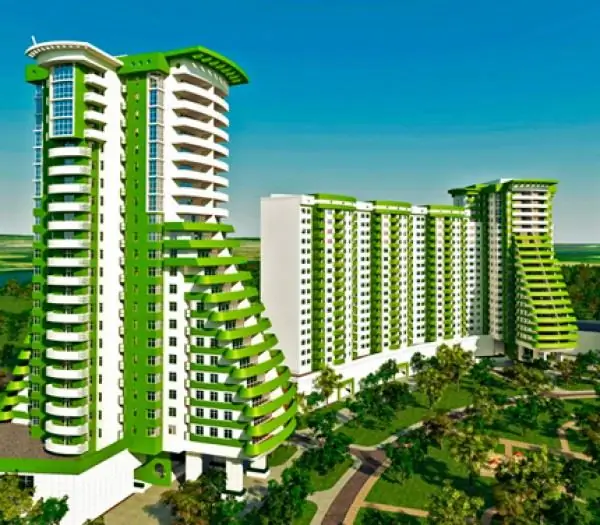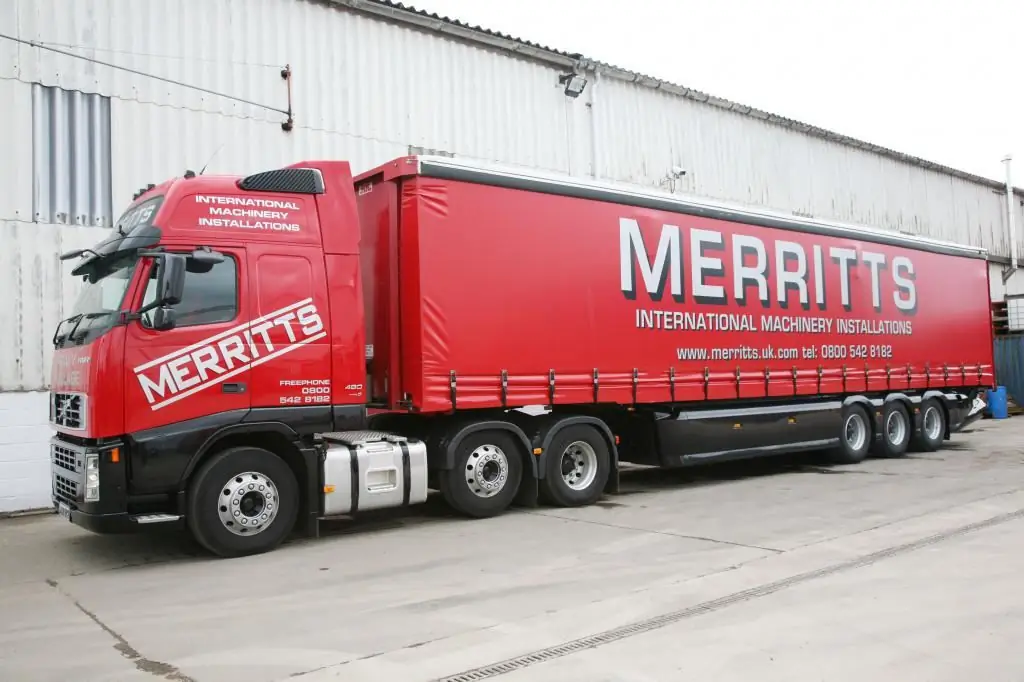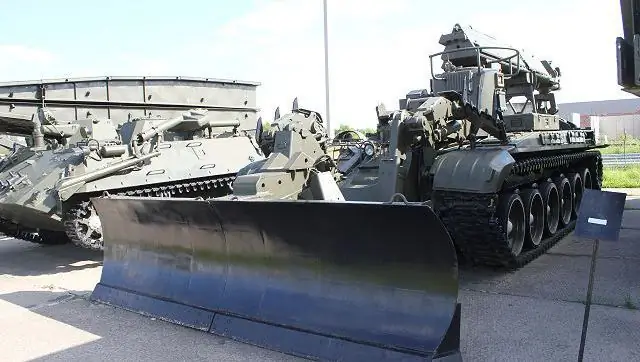2026 Author: Howard Calhoun | [email protected]. Last modified: 2025-01-24 13:10:39
Engineering Obstacle Vehicle or simply WRI is a technique that was created on the basis of a medium tank. The basis was the T-55. The main purpose of such a unit is the laying of roads over rough terrain. In addition, it can be used to equip the column track after the use of nuclear weapons, for example.
General Description
The engineering barrier vehicle has bulldozer-type equipment, which is distinguished by its enormous power. In addition, a telescopic boom with manipulator is also available. In addition, it is worth noting that the machine has a sealed structure and has anti-nuclear protection. Another distinctive feature of the engineering barrier vehicle, which greatly distinguishes it from other vehicles, is the ability to move under water. WRI is capable of being at a depth of up to 5 meters.
In addition to the listed advantages, this unit has several more. These include the radio station of the R-113 or R-123 model, the systemfire extinguishers, as well as a chemical reconnaissance device. It is worth adding to the description that the IMR has a filter-ventilation unit. It allows you to operate equipment in places where contamination with radioactive substances is observed. In addition, this protective mechanism is considered quite reliable and of high quality, and therefore the entire crew inside can do without personal protective equipment if no one plans to leave the cabin.

The main differences between the IMR and the T-55
As mentioned earlier, the engineering vehicle was designed on the basis of the T-55 medium tank. To do this, it was necessary to change the design in a certain way. The following changes have been made:
- special reinforcement sheets were welded to the bottom of the IMR, and the design of the turret formation was also changed;
- a turret was welded to the top sheet of the hull of the former tank, in which the driver is now located;
- some changes also appeared in the transmission - "Guitar" from BTS-2 was installed;
- all observation devices that the tank was equipped with were replaced with small viewing windows;
- The night vision device was also replaced - from TVN-2 to PNV-57.
As for the working parts of the engineering obstacle blocking machine, they include bulldozer and boom equipment, as well as a scraper-baker, a power take-off mechanism and a hydraulic drive.

Description of the equipment device
Regardingboom equipment, its main purpose is as follows.
- Transportation of beams, slabs, debris and other bulky items.
- Great for arranging passages through forest or mountain debris.
- Good for digging out entrances to blocked hideouts.
In addition to the above types of work, the IMR engineering barrier vehicle using boom equipment can successfully perform loading and unloading and other types of work.
If we talk about the design, then the boom equipment is a rotary telescopic boom with an invader-manipulator. If we discuss its characteristics, they are as follows:
- At the maximum reach of the boom, its load capacity is 2 tons.
- The maximum height the WRI can lift is 11 meters, and the outreach is limited to 8.835 meters.

Structural elements
A turntable is installed on the roof of the body of this machine. There is a turret place to which the inner ring of the turntable is attached, and bolts act as the main fasteners. The outer ring is also connected to the platform with bolted connections. To ensure free rotation of the tower around the vertical axis on the rotary rings, a gearbox of the platform rotation mechanism is installed.
As for the design of the operator's tower itself, it refers to the welded elements and is attached to the turntable. Obstacle engineering vehicle IMR-1 has two brackets. One of them is welded to the front wall of the tower, the other to the back. The hydraulic cylinder for lifting and lowering the boom is attached to the front bracket. For fastening, a swivel type of connection is used. The rear bracket is used to fix the boom in the same way.
The operator's tower itself is equipped with such devices as an intercom, a top hatch, a remote control, a searchlight, and a seat. To give the driver the best possible view, the cab has 6 windows.

Bulldozer equipment
In addition to the boom, the obstacle engineering vehicle, the photo of which is presented in the article, also has a bulldozer part. In this case, the main purpose is the same as that of conventional technology. In other words, it is used for loosening and transporting soil, clearing land, felling trees, etc.
This equipment is divided into smaller parts. One of these elements is the central dump. This is a fully welded construction that is attached to the frame cage. In addition, the blade is able to rotate left and right on the pivot pin, but rather weakly, only 10 degrees in any of the indicated directions. The design of the wings is built on a similar principle.
It is worth noting that the IMR bulldozer equipment can operate in three positions. The first is called dual dump and when it is activated, the width is 3,560 mm. The second position is bulldozer, with a width of 4,150 mm. Last - grader position, widthwhich is 3395 mm.

Scraper and machine drive
Another important part of the engineering machine is the baking powder scraper. Everything is quite simple here and, in addition to the two main elements, the scraper and the baking powder, this includes only the central part, represented by two beams. The mechanical part responsible for issuing the scraper is also important. It includes such small parts as a frame, rocker arm, crank, hydraulic cylinder and brackets. At the end of the frame there is a special tip. It is on him that the scraper-baking powder is put on. In this case, it is considered to be in the transport position.
One of the most important parts is the hydraulic drive. It is used to transfer both the switch and bulldozer equipment of the IMR from the transport to the working position. In addition, the hydraulic drive provides control of these elements during operation, ensures the normal operation of the mechanism responsible for turning the tower. In other words, the hydraulic drive provides almost all possible movements of heavy mechanical parts of an engineering machine.

The difference between WRI and WRI-2
It is worth mentioning that the IMR hydraulic drive has significant differences from the IMR-2 engineering barrier vehicle. This difference is as follows:
- IMR is equipped with 5 gear pumps type NSh-46d. This design reduces the total capacity of hydropower sources.
- WRI consumes less hydropower due to the fact that itsfive additional hydraulic cylinders are missing.
- The performance of hydrofilters is also reduced, since their number is only two parts.
- The IMR has no temperature sensor in the hydraulic tank, and there is no working fluid limiter.
- Safety valves type BG-52-14 are usually installed on the machine, but they do not have a complete design improvement.
It is worth noting that the amount of oil in the engine lubrication system of any type of obstacle engineering vehicle is always kept at a very high level.

Machine specifications
This machine has a number of specific specifications.
- An important parameter is the speed of arranging a passage in forest and stone rubble. In this case, the speed is 300-400 m/h and 200-300 m/h respectively.
- The speed when laying column tracks, for example, is much higher and amounts to 6-10 km/h.
- The operating capacity of the machine when transporting soil is 200-250m3.
- Regular traffic speed is 50km/h
- On unpaved roads, the speed is reduced by about half and is between 22 and 27 km/h.
- The weight of the barrier vehicle is 37.5 tons.
In addition to performance, it is worth noting that the usual calculation for such equipment consists of only two people.
Third WRI Model
Besides IMR-1 and IMR-2, another model was created -IMR-3M engineering clearing vehicle. The main difference from the previous two models is that in this case, the base of the T-90 tank was used as the base, and not the T-55.
In addition to the strong difference in design, the tasks that are set for the machine are also significantly different. IMR-3M is designed to ensure the advancement of military columns, and not for civilian use. She excels at clearing anti-tank minefields, and is also capable of cutting paths through them.
The weight of this machine is much larger and is 50.8 tons, and the maximum speed is 60 km/h, but only on the highway. As for the engine, four-stroke multi-fuel V-84MS diesel engines are installed on it, the power of which is 840 hp. s.
A slight similarity with civilian models is that the IMR-3M has a bulldozer part and a turnout. However, the second type of equipment is additionally equipped with a device such as URO - a universal working body or a manipulator. The maximum reach and lifting capacity are also the same at 8 meters and 2 tons respectively.
Conclusion
Summarizing the above, we can say the following. Firstly, the technical data of the machine is very different from the usual ones in that they are made on the basis of tanks. Secondly, the peculiarity lies in the fact that the IMR has both bulldozer and switch equipment. In addition, the built-in mechanism of protection against radioactive substances distinguishes the engineering machine from the total mass, which greatly expands its capabilities.operation.
It can be added that the tariff category of the driver of an engineering obstacle vehicle is the third.
Recommended:
LCD "Comfort Park", Kaluga. Description, features of the layout of apartments, photos, reviews

LCD "Comfort Park" (Kaluga) is one of the brightest and most interesting projects being implemented in a small provincial town. Our task is, within the framework of this material, to give it the most objective assessment, having analyzed in detail all the advantages and disadvantages
Controller of the technical condition of vehicles: job description, duties and professional retraining

The controller of the technical condition of vehicles must meet a number of requirements. Persons with incomplete higher education in the relevant direction or complete vocational education are allowed to work in this speci alty. The experience must be at least one year
Dutch tomato varieties: description, growing features, photos

Experienced summer residents and gardeners are well aware of many varieties of tomatoes bred in Holland. They have a number of important advantages. For example, there are varieties for both open ground and greenhouses, which allows everyone to choose the appropriate option
Transport vehicles: classification and types, description, characteristics

Today, the following types of transport vehicles are used in construction: land, air, sea. Most often, it is ground equipment that is used. Approximately 90% of all transportation is carried out using such transport. Among ground vehicles, automobile, tractor and railway transport is actively used
Tractor "Centaur": description, device, specifications, photos and reviews

Tractors "Centaur" occupy a niche between low-power motor-blocks up to 12 hp. With. and professional agricultural equipment. They are designed for individual home gardening. They may also be of interest to farmers with a small plot of land or as an auxiliary vehicle. The range includes models with a capacity of 15-24 liters. With

